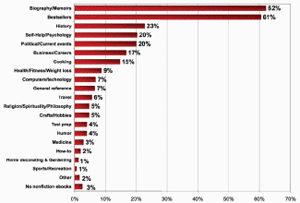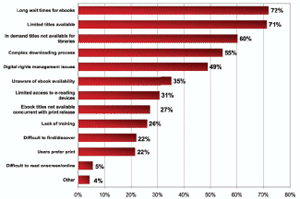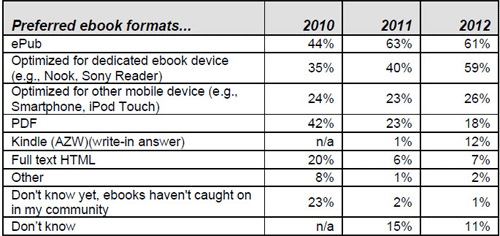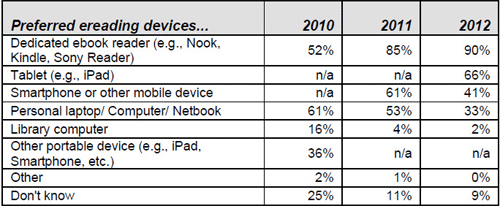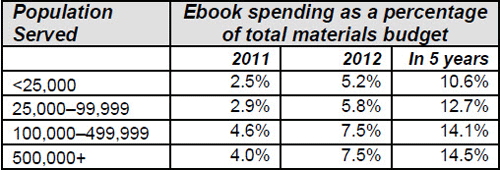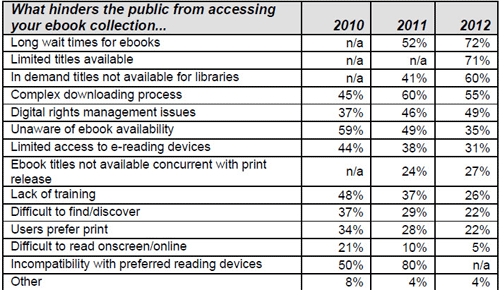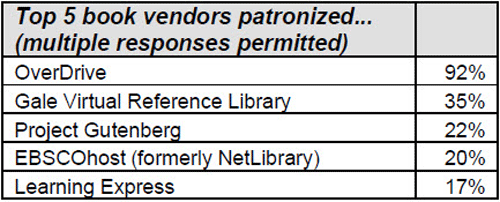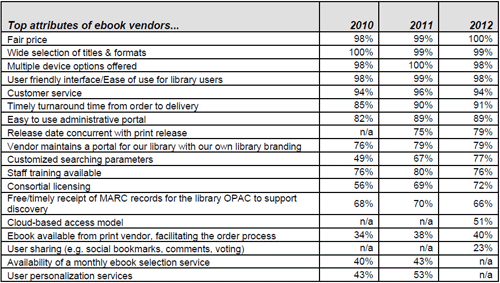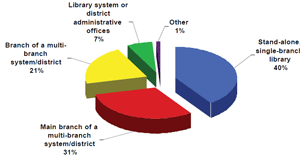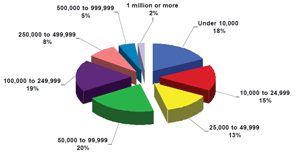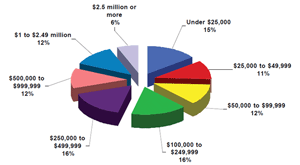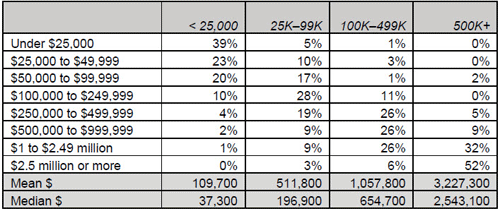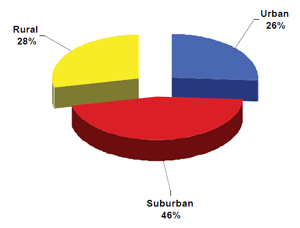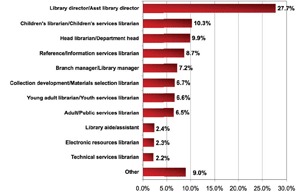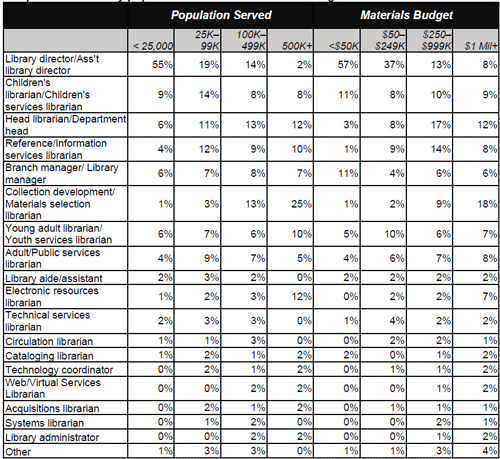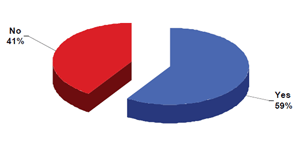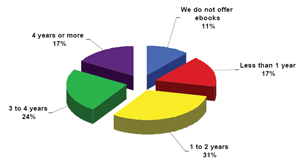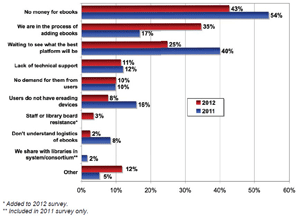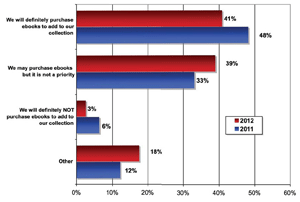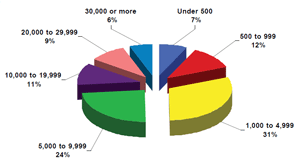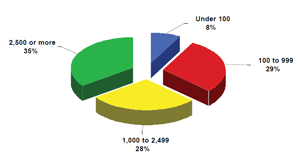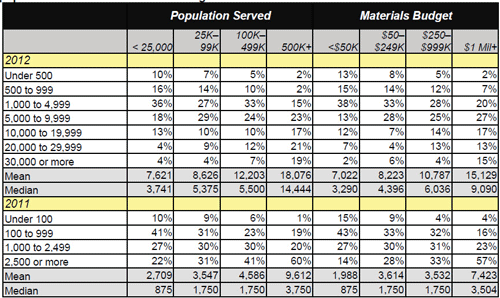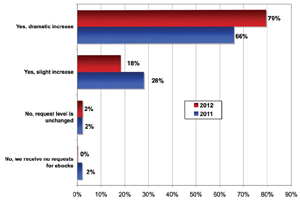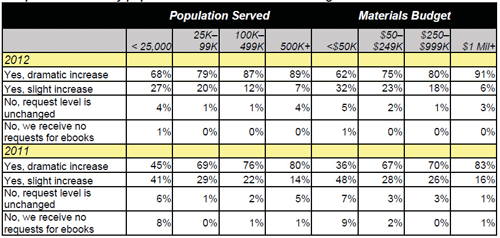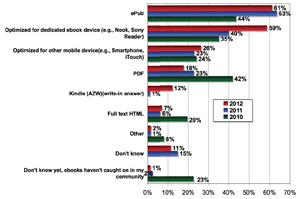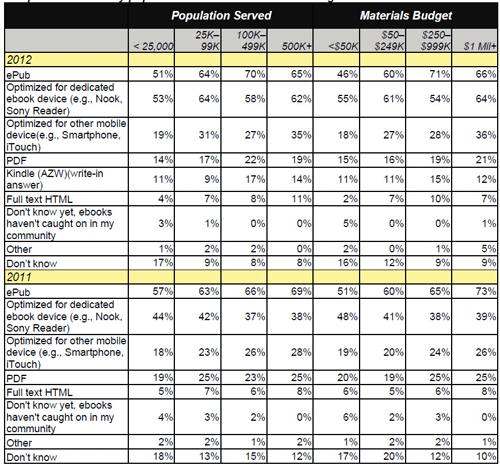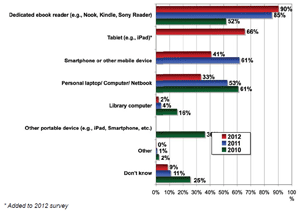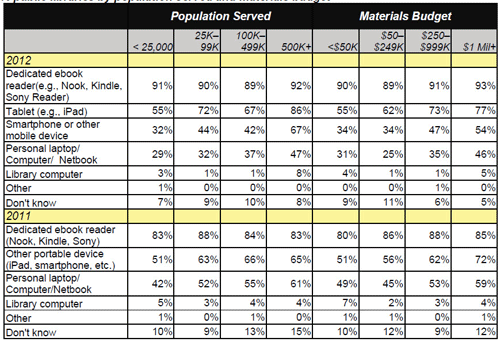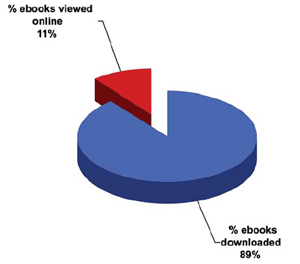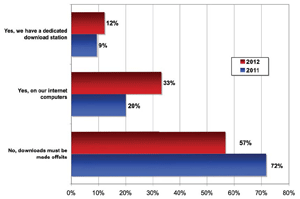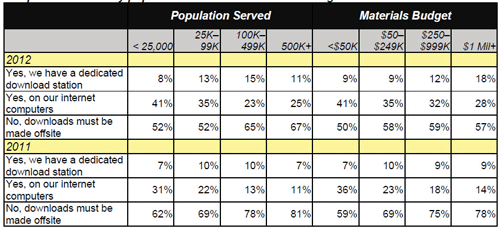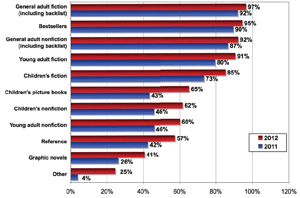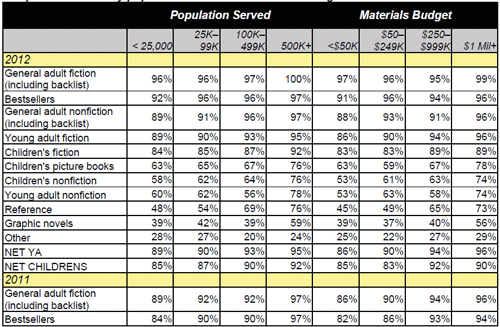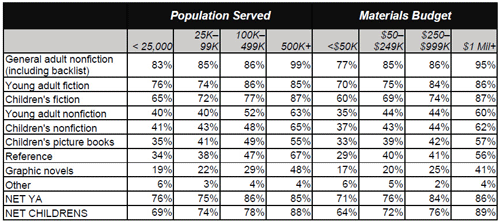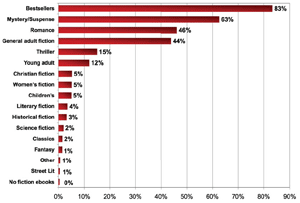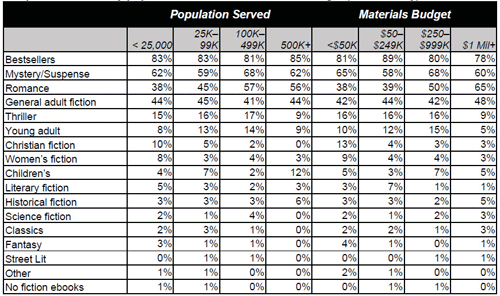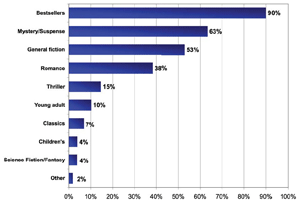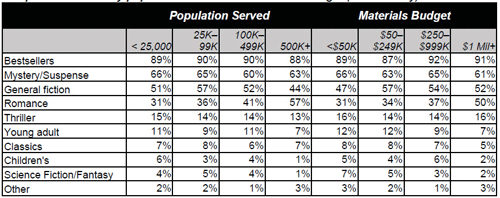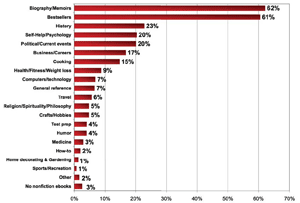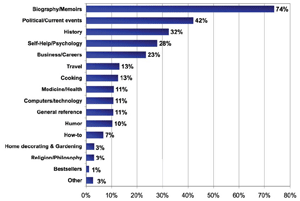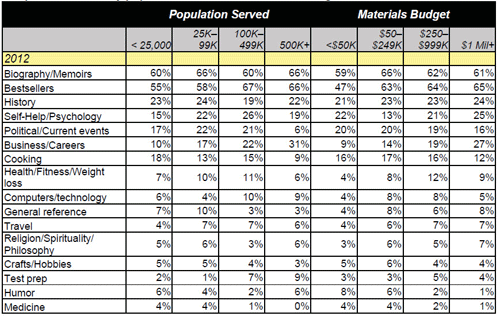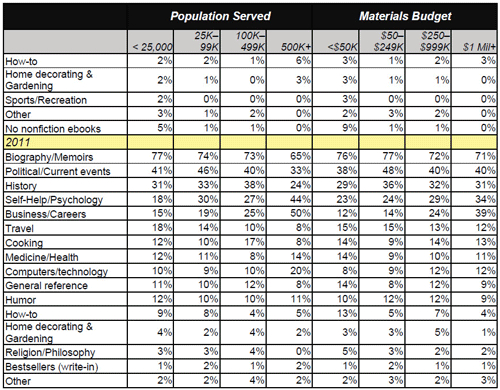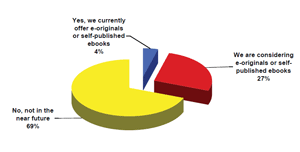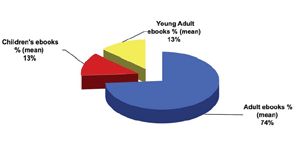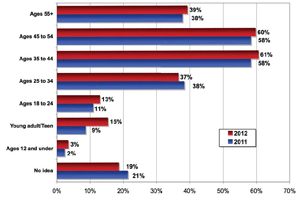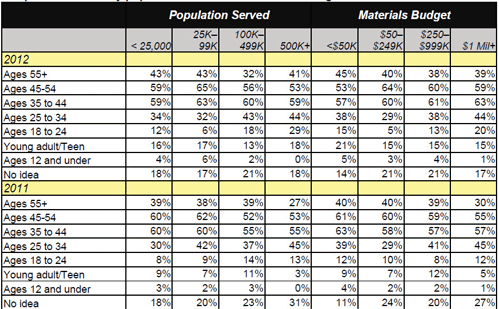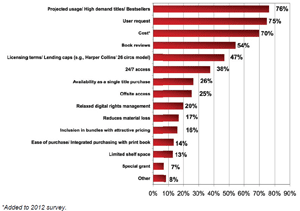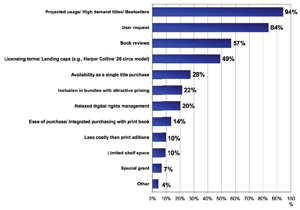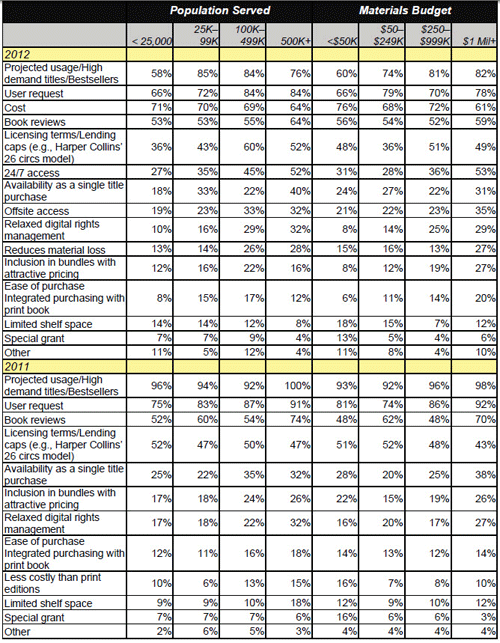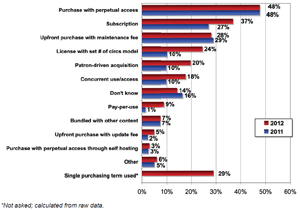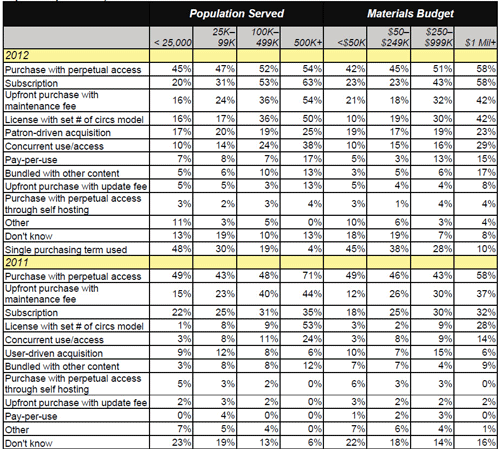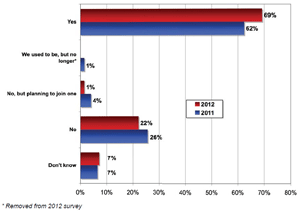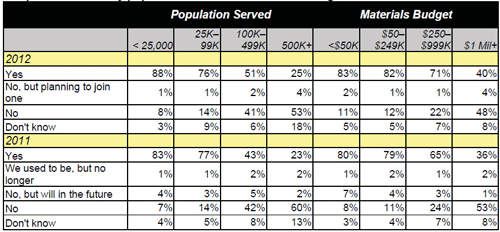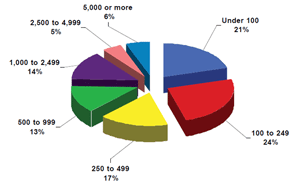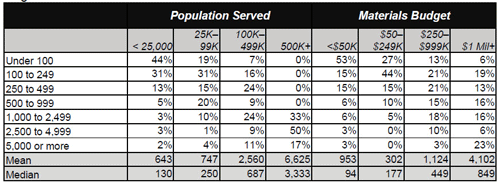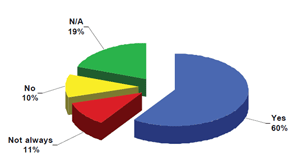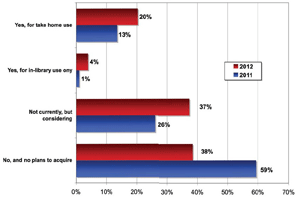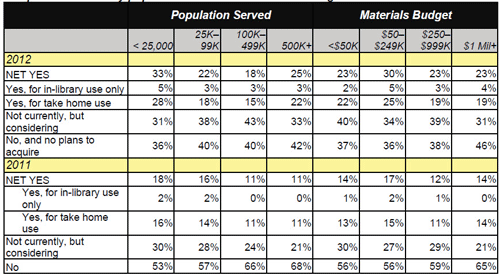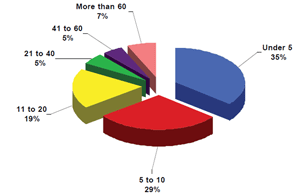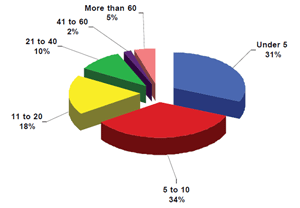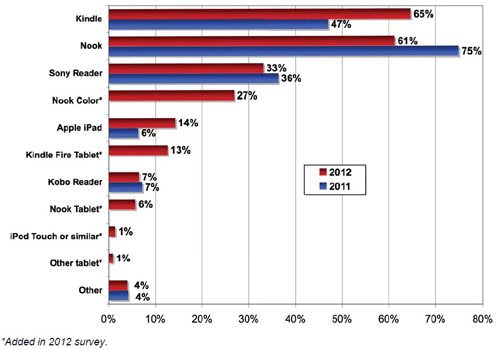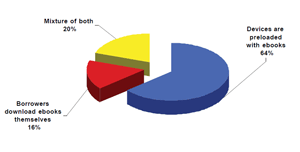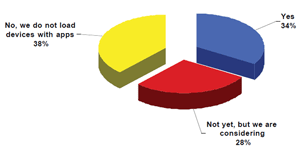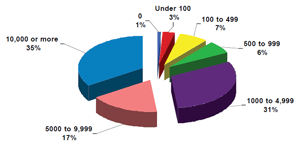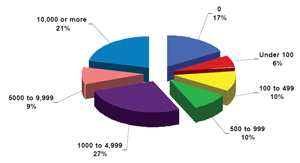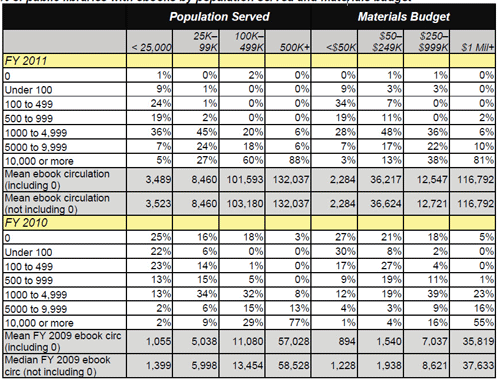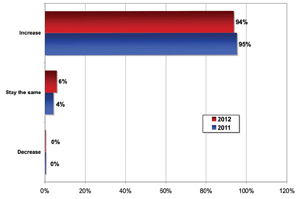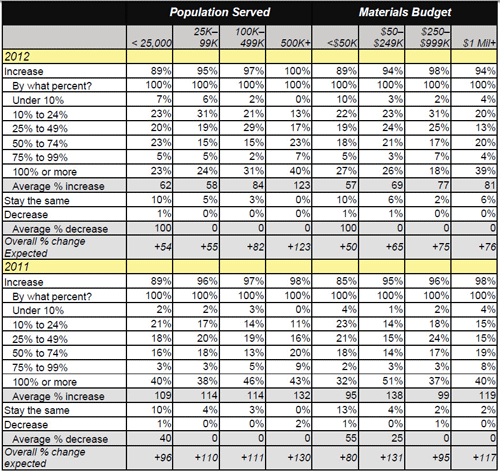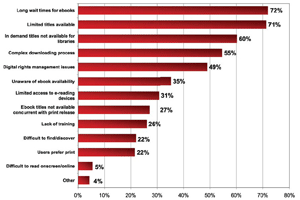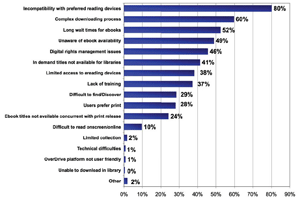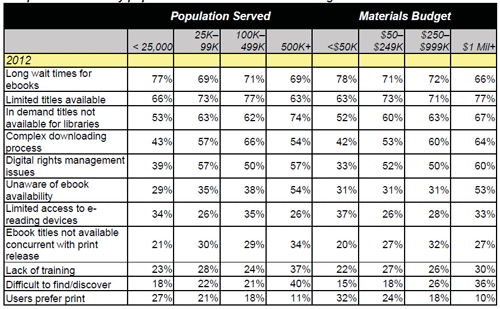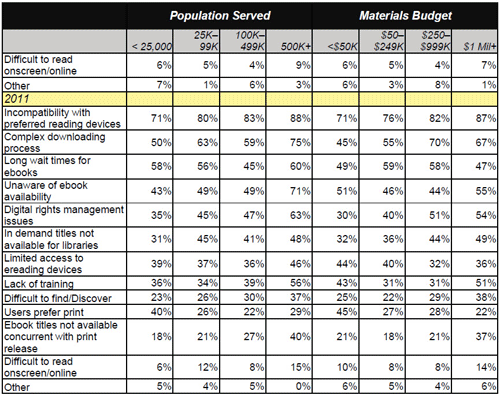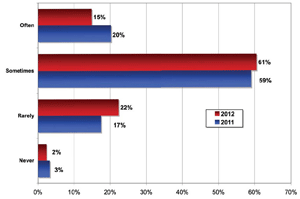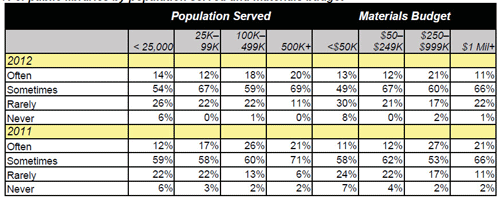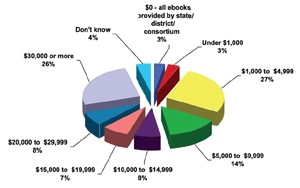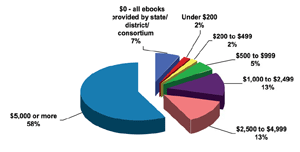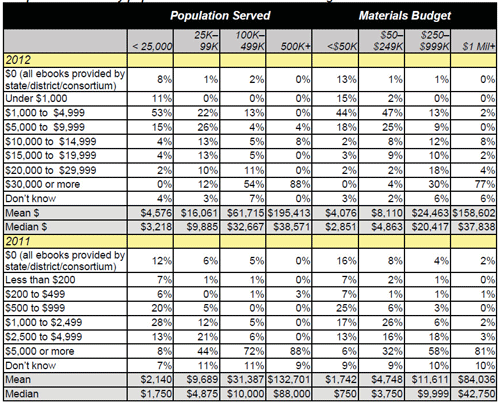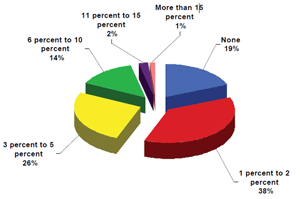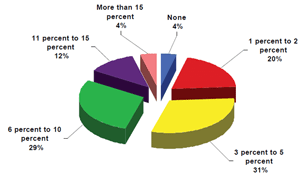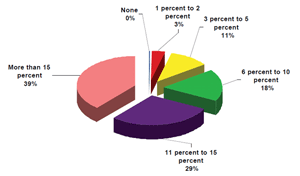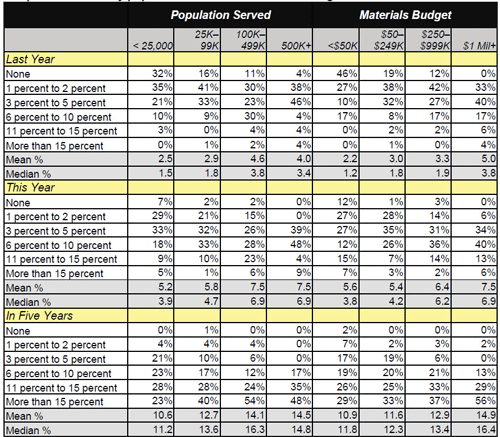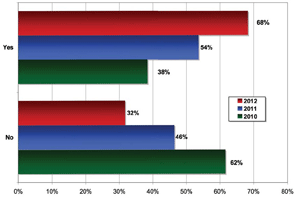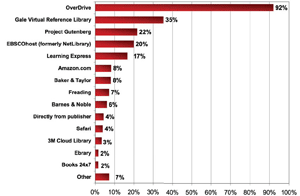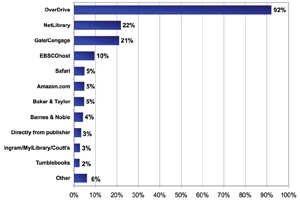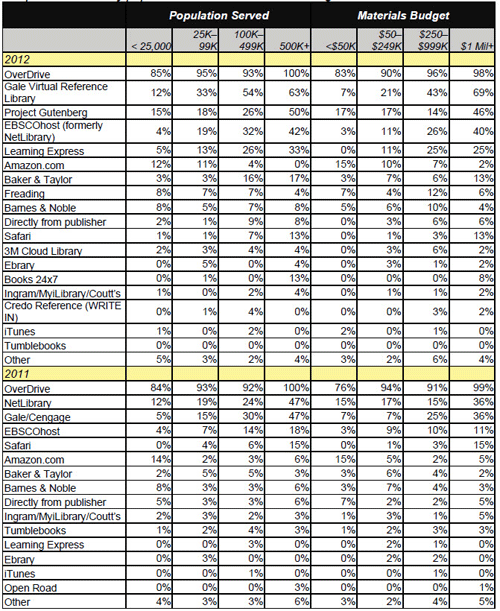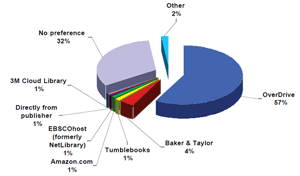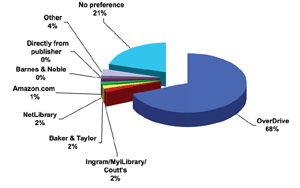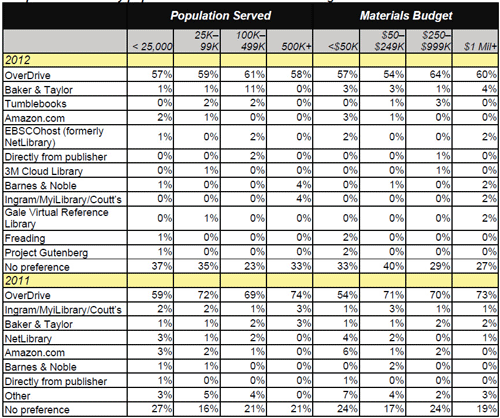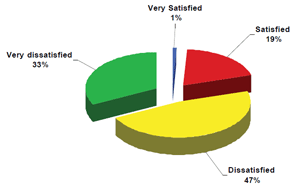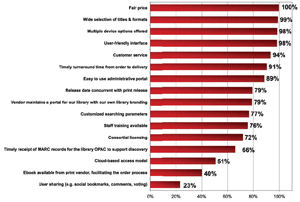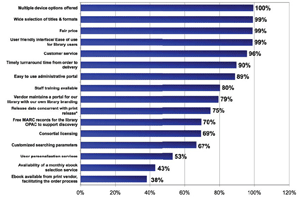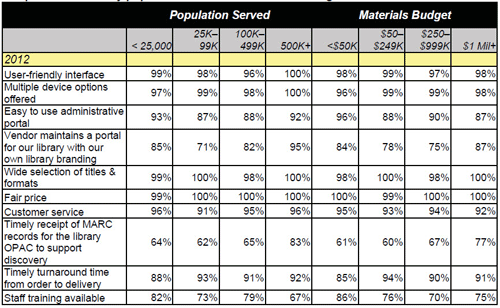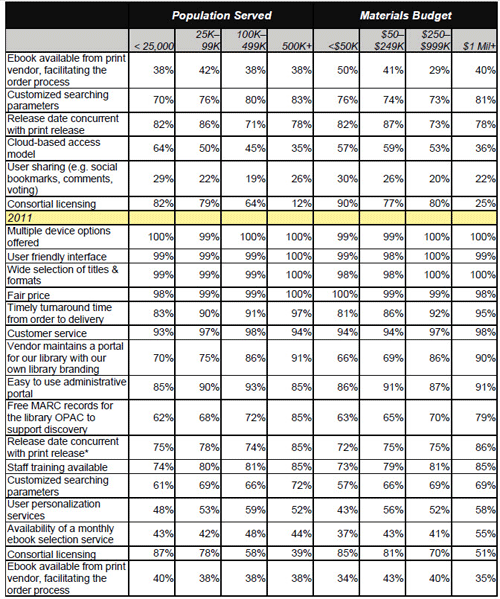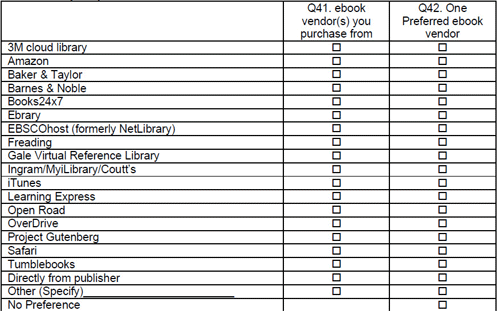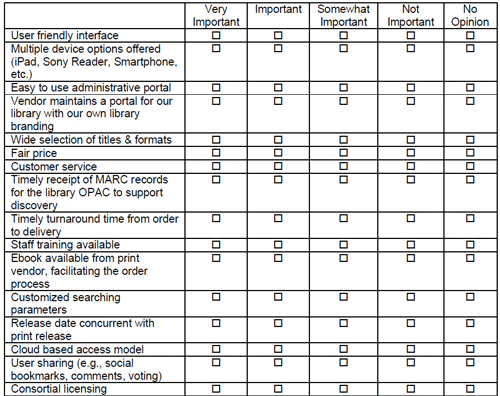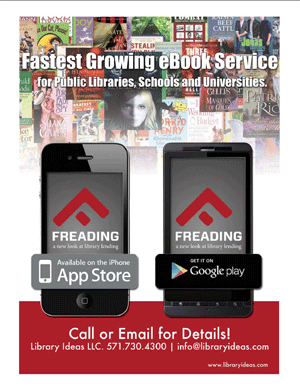by School Library Journal
© 2012 Library Journal
NOTICE: THIS WORK MAY BE PROTECTED BY COPYRIGHT
YOU ARE REQUIRED TO READ THE COPYRIGHT NOTICE AT THIS LINK BEFORE YOU READ THE FOLLOWING WORK, THAT IS AVAILABLE SOLELY FOR PRIVATE STUDY, SCHOLARSHIP OR RESEARCH PURSUANT TO 17 U.S.C. SECTION 107 AND 108. IN THE EVENT THAT THE LIBRARY DETERMINES THAT UNLAWFUL COPYING OF THIS WORK HAS OCCURRED, THE LIBRARY HAS THE RIGHT TO BLOCK THE I.P. ADDRESS AT WHICH THE UNLAWFUL COPYING APPEARED TO HAVE OCCURRED. THANK YOU FOR RESPECTING THE RIGHTS OF COPYRIGHT OWNERS.
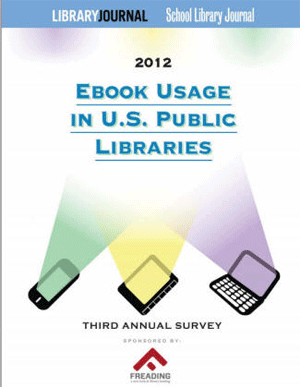
Table of Contents:
• Executive Summary
o Vast Majority Offer Ebooks
o Rapid Rise in Ebook Circulation
o Ebook Categories
o Ebook Usage Demographics
o Ebook Formats and Devices
o Expect More Spending on Ebooks
o Purchasing Terms
o Barriers to Ebook Use
o Libraries and Their Vendors
o Discounts?
o Important Vendor Attributes
o Conclusions
• Introduction
o About the 2012 Library Journal Ebook Survey
o Structure of This Report
o For More Information
• 1. Profile of Respondents
o Type of Library
o Population Served
o Materials Budget
o Library Location
o Specific Respondent Title/Purchase Authority
o Onward
• 2. Ebook Collections
o Offer Ebooks
Libraries That Do Not Offer Ebooks
o Number of Ebooks Carried
Increased Demand for Ebooks
o Ebook Formats and Devices
Ebook Formats
Hardware Devices
Downloaded Ebooks vs. Online Ebooks
o Onsite vs. Offsite Ebook Downloading
o Ebook Categories
Top Circulating Fiction Categories
Top Circulating Nonfiction Categories
o Self-Published Titles
o Age Breakdown of Ebooks
o Top Age Group Accessing Ebooks
o General Conclusions
o In Their Own Words
• 3. Ebook Acquisition, Licensing, and Circulation
o Acquisition
o Ebook Purchasing Terms
o Consortia
Buy Books Independently
Ebook Usage Statistics
o Hardware Circulation
Number of Ereaders Available
Preloaded Ereaders
Load Educational Apps
o Ebook Circulation Trends
Ebook Circulation—FY2011
Future Ebook Circulation
o Barriers to Ebook Consumption
Technical Problems
o General Conclusions
o In Their Own Words
• 4. Ebooks, Print Books, and Materials Budgets
o Current Spending on Ebooks
Ebooks in the Materials Budget
o Reallocation of Funds
o General Conclusions
o In Their Own Words
• 5. Libraries and Ebook Vendors
o Vendors Patronized and Preferred
Preferred Vendors
o Discounts
o Important Attributes
o General Conclusions
o In Their Own Words
• Appendix: Public Libraries Questionnaire
o The Survey Methodology
o Public Library ebook Questionnaire
Draconian pricing, restrictions on access, crippling DRM, and a morass of formats and devices present very real challenges to public libraries....
Our survey this year found increased frustration from libraries that are trying to provide econtent. The relationship between book publishers and libraries has scarcely been more contentious than when it comes to ebooks; piracy paranoia and instability in a long stable business model has endangered the generally amicable relationship book publishers have had with libraries—and in many cases the resulting policies (unfounded as ebook piracy has yet to become a problem) are interfering with libraries’ ability to serve their users....
As noted last year, ebooks in libraries have become “the new normal.” But looking carefully at the survey data, it seems that can be a very fragile normal. The history of technology is littered with the carcasses of previous “new normals....
Almost nine in ten public libraries currently offer ebooks to their users, and 35% of those that don’t are in the process of adding them. The top reason for not offering ebooks is not a surprise: “no money for ebooks.”...
Ebook circulation in public libraries doubled from 2009 to 2010 and quadrupled from 2010 to 2011....
“Circulation of ‘traditional’ materials at public libraries is dropping while the demand for downloadable electronic materials is rising rapidly.”...
“Demand has escalated dramatically; [we’re] having to buy works by unknown authors or only backlist titles.”...
Each survey has noted the swirl of competing formats and devices and how they are hampering further demand and ebook acquisition....
The vast majority of ebook content in public libraries is downloaded (89%) rather than read online, the opposite of what we found in academic and school libraries....
For most public libraries, “purchase with perpetual access” remains the top purchasing model, although “subscription” is increasing in prevalence (not that librarians are especially happy with this option). “License with a set number of circs” is also on the rise. “Patron-driven acquisition” has doubled to one-fifth of public libraries, and is becoming a favored purchasing model as it allows libraries to only pay for titles when users actually check them out....
If there is one thing that librarians say is deterring library users from checking out ebooks, it is the paucity of titles available. In this survey, for the first time, issues related to limited selection and long wait times for desired titles trumped every other barrier to ebook access, even technical problems. This is greatly impacted by the reality that some major publishers either deliberately refuse to license ebooks to libraries or make them cost prohibitive....
"It has been very difficult to help the public understand why there is not enough content available through the library. When staff tries to explain the costs and that only two of the big six are working with libraries, some are stunned and others walk away shaking their heads. Publishers have got to get on board and work with us, not against us.”...
[L]ibrarians are generally less than thrilled with any ebook vendor, although that animosity stems from their feelings toward the publishers themselves....
"I do not like the Random House x3 pricing—that’s simply absurd.”
“The loss of access to most publishers' titles as well as the skyrocketing cost of those that are available is severely impacting our ability to provide resources to patrons.”...
Are public librarians satisfied with the discounts they get from ebook vendors? Not at all...
The top item—selected by all respondents—was “fair price.” A close second, selected by 99%, was “wide selection of titles and formats,” followed by “multiple device options offered” and “user-friendly interface.”...
This year’s ebook survey reinforces that “price” and “selection” have become the two biggest issues for public libraries. Awareness and technical issues are being resolved. Library customers increasingly know how to use their ereading devices and get content on them, but publishers and vendors are imposing substantial barriers to customer use. The idea that some titles are not available as ebooks to libraries strikes many, if not most, librarians—and their library users—as patently absurd....
While all ebook categories have grown—“general adult fiction (including backlist)” remains the top category of ebooks public libraries offer users, growing to 97% from 92% last year (and 84% in 2010). “Bestsellers” continued to climb, from 76% of libraries in 2010, to 90% in 2011, to an all-time high of 95% in 2012. “General adult nonfiction” jumped to 92% from 87% (where it had been in 2010)....
“Classics” are also at an all-time low of 2%....
Most non-fiction categories seem to have declined from last year to this year. “Biography/memoirs” ebbed considerably to 62% from 74%, but is still up from 50% in 2010. “Bestsellers,” a new choice added in 2012, came in at 61% (in 2011 it was a write-in selection). “History” drops back to 23% from 32% last year, and “self-help/psychology” drops from 28% to 20%....
Ebooks, like on-demand digital printing, have proven to be a boon for small or self publishers. Authors who write well on compelling topics, but who never managed to crack the mainstream publishing market with its massive barriers to entry, can get their work out to the public....
In Their Own Words...As a small library, streaming content is the only affordable option. But for users of anything but dedicated e-book readers this may be the future anyhow. Why have a file physically on the client device, why not leave it in the cloud and just share access?
Budget keeps us from participating in e-books except for free ones in the public domain.
We’re concerned about how the Big 6 publishers are not all on same page and do not want to work well with libraries and therefore, we cannot offer patrons what they request.
[W]e are concerned about the pricing.
[D]esperate to get big six to relax policies of not allowing sales to libraries; bestsellers and popular titles not available; having to buy works by unknown authors or only backlist titles.
I would like to see the publishers work with libraries to establish a new model for this service.
It has been very difficult to help the public understand why there is not enough content available through the library. When staff tries to explain the costs and that only two of the big six are working with libraries, some are stunned and others walk away shaking their heads. Publishers have got to get on board and work with us, not against us.
I am an advocate for ebooks in public libraries and I have had my head handed to me for it. Ebooks are the now and the future. Publishers are pulling assets out of print and putting those resources into electronic publishing. Authors are self-publishing and bypassing publishers altogether. Bookstores are closing. Circulation of “traditional” materials at public libraries is dropping while the demand for downloadable electronic materials is rising rapidly. It is time for our profession to stop making excuses for why ebooks are bad for society. It gets old hearing why libraries should devote only paltry sums of money to develop a token collection of ebooks, when society as a whole is moving forward at a much faster pace. I think more and more people are simply bypassing public libraries (my library included) and just getting what they want from vendors like Amazon. ALA should have been working with ebook publishers years ago to make sure that libraries had a meaningful place at the table. Instead, ALA did nothing significant until 2012 to work with publishers to make libraries an important part of the ebook model. Instead, many in ALA had for years been busily embracing the print future because it was more comfortable and easier for them to do, despite the fact that it had nothing to do with where the world was actually headed. Yes, I have heard all of the digital divide debates. I have had people tell me that they need to feel the book in their hands. I hear arguments all the time that we should not have ebooks because having them puts the poor at a disadvantage. Yes, the licensing issues cause concern for some people. I hear that our library is doing too much, too quickly, but our circulation statistics for traditional materials continue to fall by double digits each month, while electronic materials continue to soar. At the end of the day, the solution to all of these issues is not to buy more print materials with the hope that this will somehow meet the needs of modern society.
I just wish that the ebook publishers weren't so reluctant to work with libraries. It's very disheartening.
[C]ustomers are used to an easy downloading experience, which they will not get from the library. The downloading process for many of the readers is clunky and has more steps than our target audience wants to go through—especially our senior citizens who offer up their new device to us and expect that we will just magically check out the book to it.
I think libraries need a national consortium that can create our own channel, possibly our own easy to use platform. The monopolies are too powerful for libraries to deal with this issue independently.
DRM and reticent publishers are the real hangup.
I wish publishers would get their act together re pricing.
If we don’t figure this out, we’re sunk.
It is an increasingly popular format for most libraries. I feel that the publishers are taking advantage of this by inflating the prices of the ebooks. The money they are making is almost pure profit (no paper or ink used, no shipping costs, etc.) and to jack up prices artificially to libraries, who have historically made information available to the masses, is immoral.
[N]ow with publishers, Amazon, Apple all against us ... now that we have ebooks we can never go back, but are on the tech treadmill for this item too, just like databases.
Libraries and library associations must put pressure on publishers to sell ebooks to libraries at a fair price.
Would like to be able to offer a download station for patrons in the library, but can't because of all the restrictions.
WE are frustrated by not being able to obtain all the titles we would like to offer. ... I can’t understand why any author or publisher would not want a book to be available in e-book form. A sale is a sale. Ebooks are no different than paper books.
Our greatest concern is being able to get popular materials quickly, at a fair price, that are compatible with popular devices. This is possible only to a very limited degree.
Our Kindle patrons have had trouble downloading best sellers because of the lawsuits involving OverDrive and Amazon.
Our library, and I think many others, want a solution that makes ebooks easily available in the same way physical books are easily available. A customer goes to the library for a physical book, picks it out and then checks it out—no special knowledge is needed for how to remove it from the shelf. Ebooks need to be the same—a customer picks it out from our catalog or online presence and checks it out. They shouldn’t have to know 5 or 6 different platforms differing requirements in order to check out their choice.
Our major vendor is OverDrive. It is ridiculously hard to use.
[I]t’s frustrating that not all in demand titles are available as an ebook (i.e., Hunger Games). Also, the prices are frustrating. Some are very well-priced but many seem extremely overpriced.
Publishers not getting on-board with this movement are just shooting themselves in the foot. Sometimes we hear from patrons “Why can’t I get this book? Why don’t you own it?” and we just tell them the truth: “The publisher/copyright holder has chosen to not make it available to libraries. We absolutely would, if we could.”
The ability to be able to provide any ebook from any vendor from the same platform would be a major benefit for libraries and patrons.
The current ebooks-in-libraries situation is terrible, period. This is a classic situation of cutting off one’s nose to spite one’s face. If we could afford to do it, we would strike out on our own à la Douglas County, Colorado, because ownership of materials is VERY important to us.
The demand is high and difficult to meet with our current budget.
The ebook demand in our library is phenomenal. We need publishers to allow libraries to lend their ebooks. Libraries traditionally spur purchases of print books and materials. Limiting or denying the public access to ebooks is detrimental to the publishing business.
The inability to purchase many popular titles is a critical concern for public libraries. We must get this resolved with publishers.
The loss of access to most publishers' titles as well as the skyrocketing cost of those that are available is severely impacting our ability to provide resources to patrons. We are depending on the state and national library associations to take action, whether in lobbying to legislators or legal action, it cannot happen quickly enough.
The market is growing and our ability to purchase is shrinking with excessive publisher demands and limitations for libraries. Knock it off, publishers!
The Content Reserve site is one of the worst sites I have ever used for book purchasing. It is so frustrating that many e-books are not available for purchase through them.... I wish Overdrive offered the same titles as the other providers at the same time.
The publishers are killing us by not releasing bestsellers via e-book vendors.
... limited availability creates a sort of catch-22 effect. People give up on it because of the wait, and the library can’t afford to order what is not being used.
Tired of secondary purchases and illogical pricing. Our vendor has a horrible catalog where searching proves more than frustrating. Want more MP3 audiobook titles. Mostly tired of explaining to the patrons why we can’t get the books they want.
Use seems to be decreasing as waiting time for holds increases.
We are on the verge of being priced out of the ability to purchase ebook licenses to lend to our public and are thinking about alternate options....Libraries are trying to preserve the legality of ebooks in today’s market. Readers in general are in trouble if one major retailer is allowed to dictate the terms of use for everyone else.
Publishers continue to not work with libraries or not come up with a viable solution for libraries loaning ebooks.
We have a four-year contract with OverDrive but are frustrated by their overall attitude toward customer service and by the increasing prices or outright unavailability of popular ebooks.
We just wish we could provide the ebooks our public library readers want. The majority of the time we can’t, because publishers won’t sell them to us.
We only launched our e-book “adventure” 30 days ago, so trends are not clear yet. We are, however, horrified at the prices and the lack of current released materials.
We use Overdrive because the Colorado consortium uses Overdrive. Joining was the only option that would give us instant access to a lot of titles. In reality, it gives us instant access to the waiting list for a lot of titles.
[T]he minuses: no current bestsellers, limited popular fiction, not compatible with plain Kindle which is the device that most people already own, at least locally.
We would have more ebooks if the licensing allowed and we could keep them. But the subscription model is not good for any one but the middle man. Prices are out of sight and impossible for small libraries. Wait lists in consortium models can go on for months. People are starting to catch on and get angry at publishers and vendors. It’s time that middle men vendors stop enabling bad business practices.
Would like a model that permitted ownership rather than just a subscription. We are spending large amounts of money that could result in nothing to show for it at some point.
Would like more titles available including more copies of best sellers....
Consortium members bought on average almost 1,400 ebooks independently....
But virtually across the board, circulation increases are slowing down compared to last year....
The biggest barrier to ebook consumption, say public library respondents, is “long wait times for ebooks,” selected by 72% of public libraries, up 20 percentage points from last survey. “Limited titles available,” a new choice, came in at 71%. Likewise, “in-demand titles not available for libraries” is at 60%, up from 41% last year. We see a theme emerging...
“Complex downloading process” ebbs to 55% from 60% last year (it was at 45% in 2010). “Digital rights management issues,” the perennial bugaboo for all ebook readers, be they libraries or not, climbs to 49% from 46% (and an all-time high for this item; it was at 37% in 2010). “Users prefer print” drops to 22%, an all-time low for this item....
If there is one thing that will deter library users from checking out ebooks, it is the paucity of titles available. In this survey, for the first time, issues related to limited selection and long wait times for desired titles trumped every other barrier to ebook access, even technical problems. The reason is that major publishers either deliberately refuse to license ebooks to libraries or make them cost prohibitive. Simon & Schuster, Macmillan, and Penguin do not sell to libraries, and Hachette withholds the latest titles, although Penguin began an experiment earlier this year. Random House is “free and easy” with its ebook licensing, but recently boosted prices for ebooks by as much as 300%. (See the verbatim comments for some candid thoughts about that.) And HarperCollins has their much-criticized “26 circs and then rebuy” model [10] although some libraries now admit that this is better than nothing....
Comparing medians, libraries plan to spend about $10,000 on ebooks in the current fiscal year....But note that more than one-third (34% of public libraries plan to spend $20,000 or more on ebooks in the current fiscal year....
According to our 2012 survey, last year ebooks accounted for, on average, 3.3% of public libraries’ total materials budget. [13] This year, that has almost doubled to 6.2%....
In last year’s survey, public libraries felt that ebooks would represent, on average, 8.8% of their materials budget in five years (i.e., 2016). In this year’s survey, our respondents upped the ante and now feel that ebooks will account for, on average, 12.6% of the materials budget in 2017....
In five years, virtually all size libraries expect to be spending more than 10% of their materials budgets on ebooks....
Well, it doesn’t look good for print materials. In our 2010 survey, 38% said they reallocated funds. Last year, that rose to more than one-half (54%) of respondents. Now, in 2012, almost seven out of ten (68%) public libraries say they reallocate funds from print or other physical materials to pay for ebooks....
Average spending on ebooks is almost doubling each year, and ebooks represent an ever-expanding percentage of libraries’ overall materials budgets. One point mentioned earlier bears repeating: In 2010, 27% of libraries felt that by 2015, ebooks would account for more than 10% of their materials budgets. And now, only two years into that five-year period, 16% of public libraries already report that ebooks represent more than 10% of their total materials budget.
As libraries acquire a larger and larger collection of legacy and backlist titles, overall purchasing will level off and decrease, as they will only need to keep up with current releases (or, in the case of HarperCollins titles, keep re-buying older titles once the 26 circs are up).
However, it doesn’t look good for print, as an ever-increasing number of libraries are reallocating funding from print titles (and elsewhere in their materials budgets) to pay for ebooks. This probably means fewer print copies of new releases, but also less frequent replacement of worn and damaged backlist titles....
OverDrive is by far the top vendor patronized by public libraries for ebooks, largely because they are one of the only games in town....
Are public librarians satisfied with the discounts they get from ebook vendors? Not at all: a full 47% are “dissatisfied” and a further 33% are “very dissatisfied.” Only 20% are at all satisfied, and only a scant 1% is “very satisfied.” Given the tone of most of the verbatim comments regarding pricing, it’s surprising that as many as 20% of libraries are satisfied....
Not unexpectedly, the most vitally important attributes are a mixture of pricing, selection, and device support. The top item—selected by 100% of our public library respondents—was “fair price.”...
In Their Own Words...Annual fee to vendor is also very expensive.
A big increase in March was shocking.
Book prices on “Overlord” have steered us away from that platform.
Disgruntled with price hikes.
Ebook prices are too expensive. over 50 years. The 26 circs per year model needs tinkering but eventually could work.
Hard to build a collection when prices are so high, not to mention those with the 26 checkout limit.
I am dissatisfied that prices are increasing though publishers’ costs for ebooks is static and low.
I do not like the Random House x3 pricing—that’s simply absurd.
Random House is completely irresponsible in their pricing to libraries, and we refuse to buy their titles. Sorry to see that Penguin is no longer selling titles to libraries, as we have enormous hold lists for books and can’t do anything about it.
Increases in pricing from some publishers has greatly discouraged our purchasing habits.
It is RIDICULOUS! Just when I think they can’t get more expensive, they keep going up. And when books become popular the price SKYROCKETS! I just don’t know what to do with it.
It’s the publishers’ pricing that seems to be the issue, such as Random House’s recent triple increase.
Look at Random House pricing on OverDrive. Absolutely ridiculous.
One publisher’s price has TRIPLED within the last few months. I really have to think long and hard before spending $75.00 for an ebook.
Pricing as we all know is absurd! There is no relationship between prices asked and the real cost to the vendor to provide this content.
Pricing is all over the map. Particularly disappointed with recently tripling of ebook prices by some vendors. Subscription based books should be priced like paperbacks because they are virtual paperbacks.
Pricing is out of control. The publishers are at war with libraries.
Pricing is unfair and intended to drive libraries out of the ebook market.
Pricing is way too high and I’m not sure who is driving the pricing model, the publishers or third-party vendors. In any case most of the problems getting ebooks are square in the laps of the publishers who refuse to see ebooks as just another format and adapt to it. No library in the world is going to stop private purchase of ebooks by the public any more than our having paper books stops people from buying paper books!
Pricing model from Random House has led us to not purchase any RH content, severely limiting user access to many bestselling titles. Paying $75–90 for an ebook is not fiscally responsible in our minds.
Publishers are sticking it to libraries when it comes to ebook pricing. The cost to produce ebooks is much less than producing printed books, but then some publishers fear that a library will purchase one ebook and circulate it without limits to anybody, so they jack up the prices to “defend” against such practices. It’s nonsense. Make no mistake. Publishers currently see public libraries as competition, not allies, and it is a shame.
Publishers have been horrid to libraries—I won’t buy HarperCollins or most Random House titles because of their excessive charges to us.
Publishers need to understand that ebooks are the same as hard copies. They have sold books to libraries for years, selling to libraries is not going to drastically hurt their sales. Only so many people are going to buy books—electronic or otherwise.
Publishers’ pricing for ebooks for libraries is ridiculously expensive. Vastly unfair for libraries given the lack of government funds for libraries in this recession. Especially unfair given the typical $9 price tag for Kindle ebooks, and the lack of “gift” ebooks libraries get from patrons compared to print format gifts. Libraries have helped encourage literacy and reading for centuries, and publishers are treating them very unfairly!
Random House is greedy, other big publishers should be taken to court for refusing to sell to libraries.
The prices were reasonable when we signed on with OverDrive and then went up to a point where we purchase slightly older titles instead of new releases.
The publishing industry charges too much and places absurd restrictions on lending—one copy, one reader; limits on the number of circulations; titles that are only good for a set time and so on.
There are no discounts. We are forced to pay retail prices or above, and some publishers are gouging, which reduces the number of copies of in-demand titles that we are able to purchase.
There are no discounts. In fact, bestsellers are often more expensive. Pricing is completely arbitrary and uncontrollable.
There is no discount. We sometimes pay triple the print cost.
We are buying less Random House titles because of the enormous price increase recently.
[P]rices are outrageous for most.
We do not get discounts, Random just raised their prices to the point where we may stop buying and Harper’s cap makes us think twice before we purchase. Penguin pulling out of OverDrive makes it difficult to offer a solid collection.
We don't get any discounts from ebook vendors and publishers like Random House are making ebooks un-affordable.
We don’t get discounts and some publishers are charging 3X the cost of the print book.
What discounts? The prices we pay are higher than consumers and much higher than we pay for physical copies. With the Random House price increase I seriously have to consider purchasing those titles as it’s hard to justify the expense.
-- EBook Usage in U.S. Public Libraries: 2012, by School Library Journal

